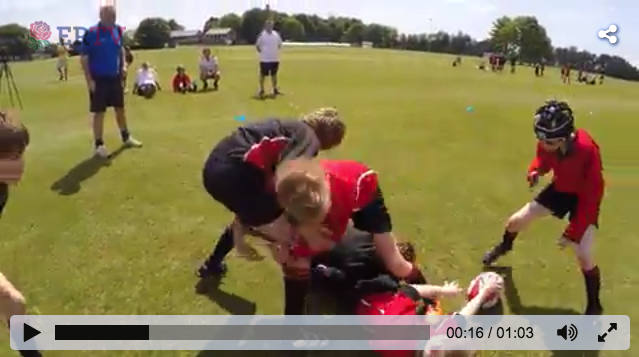Is there time to develop the ruck or do we have other priorities?
I meet and talk with youth coaches and plan the development of the rugby players. I present the development model and we discuss how Supercoach Online facilitates and structures the development program. Then the question pops up: why no exercises for rucks in the Under 10 target group?
How does it fit?
My development model is based on various LTAD programs of different unions and sports, but it is strongly embedded in the FFR development principles.
Step 1: the individual project: learn the U6 / U7 Ball Carrier to look forward, recognize and attack space, evade defenders;
Step 2: the collective project: learn the players very near to the Ball Carrier to get actively involved with keeping the ball alive. “The Rest” need to look for the space elsewhere and position for the next attack;
Step 3: deliberate use the space in front of the defense: ball retention, recycle, lateral play & penetrating play;
[there is 4 & 5, not relevant for this discussion]
So, the obvious choice is to do the ruck / maul stuff in Step 3: U14 and older (perhaps U12 if your team is very much ahead). In Step 3 players know that if we cannot keep the ball alive, we must fight to keep posession, make a quick recycle and after some lateral play attack space somewhere else.
How much time do we have?
Okay, good question. Let us say we train twice a week for 40 weeks and a session takes 1 hour (these are young kids!). This means you have 80 hours to work with. Not a lot if you realise children learn by repeatedly doing the same sort of exercises. Let us check some boxes:
- Want to develop seeing and using space, evasion, etc: decision making in Open Play? absolutely
- Want to develop Fundamental Movement skills, like Movement Dynamics or SAQ Elementary Movement Patterns? Of course, this is the best time to do it
- Want to learn catching and passing? Naturally!
- Tackle? No question about it
- Play a game? Yes, let’s have some fun
So this is already of 80% of that 80 hours gone, perhaps more.
Make the rugby experience all-inclusive
Recent research by the NZRFU showed that young players are afraid to get in the way of the players that are more experienced, they do not understand the flow of the game. The research papers advised to make the programs more ‘all-inclusive’ and spent time (out of those 80 hours!) on explaining the game: how to restart, how to line-up. Okay so….
Restarts, why and what to do?
Now this is an interesting aspect: when do we introduce which restarts in the age grade game? Research by the R.F.U. showed we need to do less, but the R.F.U. had to compromise when they made the final set for the “First Kids Rugby” program. So:
- Kick-off? No, just Free Pass;
- Scrum: yes, uncontested 3v3;
- Line-Out: no;
Following the advice of the NZRFU report we need to spent time on restarts. Scrum itself but also how we move from the scrum situation into Open Play, and it is the same with Kick-Off and Free Pass. This would be good to do at the start of the season. At least 10% (only eight hours!) of our 80 hours budget to allocate to scrum and restarts? Now we are on a “tight budget”;
Time needed for Ruck?
Ruck fundamentals first: what are the options for the first attacker arriving at the tackle situation?
- Pick-up the ball and go forward
- Pass the ball
- Occupy the space above the ball
- Clear defenders of the ball? (This might leave the ball exposed for the next defender)
How to coach both technical aspects and the tactical decision making? How much time is left of our 80 hrs budget? Not enough!
What do some clubs do?
I see this sequence being taught and very well executed:
- Take the tackle;
- Go to ground;
- Present the ball;
- First supporting player: occupy the space above the ball;
Easi-to-coach into a team, and perhaps very effective even, but completely opposite to the keeping the ball alive approach we want our players to take: the danger is we focus on recycle and with the above sequence start playing in front of the defence only. Can children understand both? I think older children can….
What is your take?
Building training programs is all about making choices. You guessed it already, I go for the later introduction, focus on space and life of the ball is the priority. Unstructured perhaps, but more in line with Deliberate Play practises. And more importantly: you simply do not have the time to do it all.
The R.F.U. decided to control the contest of the ball after the tackle by limiting the number of players of each team allowed to go for the ball. It is an interesting approach! Now we can focus our players on presenting the ball in the tackle (during the tackling exercises) and to pick up the ball and go forward again (Open Play) and we can leave the Ruck alone for now.
[Strangely enough the video clip the R.F.U. made shows a clean-out after the tackle, confusing….]I am interested to know how you approach this, please let me know.
Related Information
- C.A.R.D.S. are shaping England’s future players;
- SAQ International’s eEMP award course (Elementary Movement Patterns;
- The perspective of the Barbarians on rugby, no ruck but run into space;
Subscribe and get notified when I add new posts
